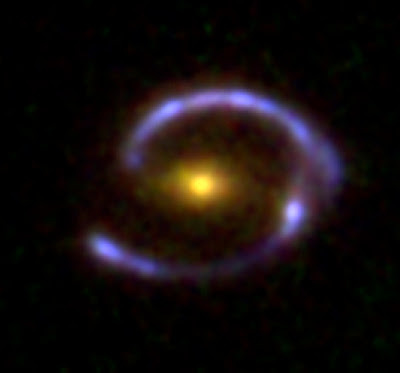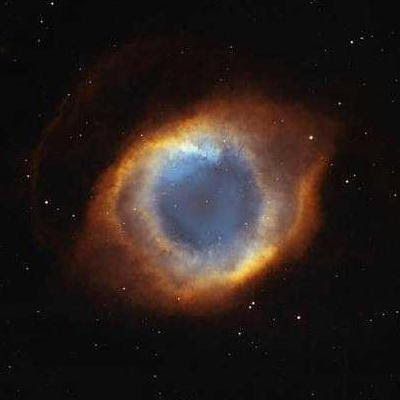I Spy With My Little Eye

That this looks like a giant eye in space is only the mildly cool bit.
The wildly cool bit is what causes the image to form. It's a gravitational lens, otherwise known as an Einstein ring.
The "pupil" of the eye, at center, is a galaxy 2 billion light years away. Directly behind that galaxy is another one, 11 billion miles away.
Follow me here: the extreme gravitational forces from the close galaxy bend the time and space around it, forming a sort of lens. Not figuratively. Literally. It's a giant lens made not of glass, but of space itself. Let me repeat that: it's a lens made of bent space. The lens distorts and magnifies the light from the faraway galaxy, bending it so it looks like a bright ring around the close one. Normally, the faraway galaxy would be too faint to see. The lens magnifies the light so that we can.
I don't know why it's blue. Perhaps it's a false color image. Or a Doppler shift of some kind.
Einstein predicted this kinda stuff would happen if we looked deep enough into space (something we couldn't do at the time he predicted it). That's why it's sometimes called an Einstein ring.
Is that cool, or what?
I grabbed the image, and the details, from the always interesting Bad Astronomy blog. I asked him why it was blue, but he's too famous to answer. He even gets interviewed on Art Bell!
Anyway.
While I'm at it, another space eye.

This is the Helix Nebula, sometimes called the Eye of God Nebula. It is much closer - a mere 700 light years away - and was created by the death of a star in our own galaxy. The resultant explosion created a tube of glowing gas along the poles of the star, and we're looking down that tube. Look closely and you can see original star, at the center of the picture.
First photo is from the Keck observatory. Second one is from the Hubble. Both are from NASA.



